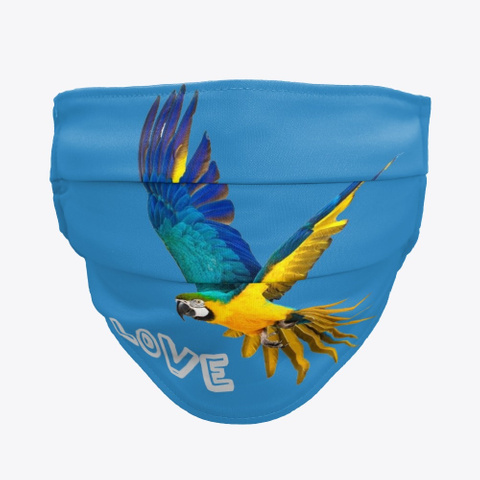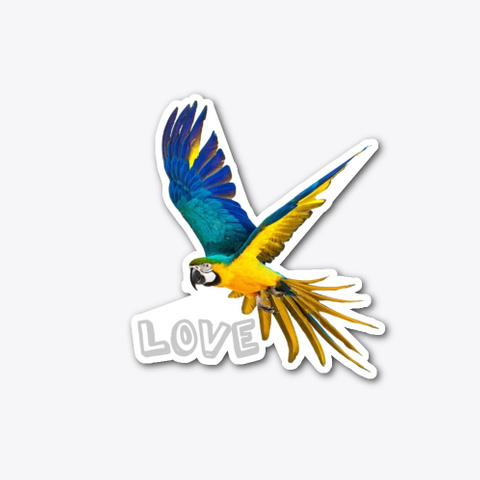Check out our merchandise
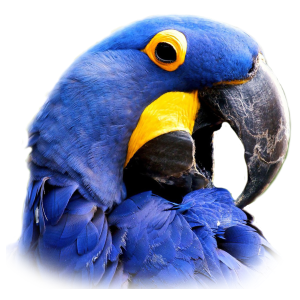 Macaw is a very bright and multicolored parrot that is native to Central and South America and around 17 different species of them are available in the rain forest of South America. Blue Macaw also known as Hyacinth Macaw is one of their species that is considered as the largest macaw species with a length of about 100 cm. Blue macaw is becoming much more popular as pets but their declining population in the wild is another threat to the world of animals that is caused due to the destruction of their natural habitat rainforest in central and South America at an alarming rate.
Macaw is a very bright and multicolored parrot that is native to Central and South America and around 17 different species of them are available in the rain forest of South America. Blue Macaw also known as Hyacinth Macaw is one of their species that is considered as the largest macaw species with a length of about 100 cm. Blue macaw is becoming much more popular as pets but their declining population in the wild is another threat to the world of animals that is caused due to the destruction of their natural habitat rainforest in central and South America at an alarming rate.
Description
This macaw species is the largest parrot in the world having a full length of around 100cm from the top of head to the tip of the tail. The tail is very pointed and its body is covered with entire blue colour feathers. However, sometimes the neck can be slight grey. The wings are long enough that are around 388-425mm long. They have yellow facial skin with black under wings. The immature have short tail and paler yellow exposed facial skin while the adults have white or lighter grey color legs.
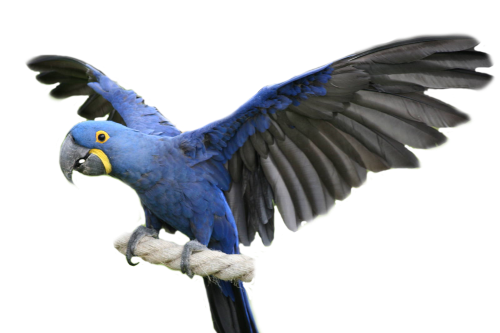
Like any other species of macaw, this blue macaw too has a very powerful and long beak which helps them easily break seeds, nuts shells and other similar foods. A dry and scaly tongue along with a bone inside it ensures that species can easily tap into fruits. Four toes on each foot with two toes facing forward and two facing backward help them latch into tree branches and easily grab foods. These kinds of toes are helpful that prevent them from getting slipped off.
They are social bird and are seen together in a large group of around 20-30 parrots. This intelligent bird can mimic human also while they communicate with each other through screaming and squawking.
Geographic Range
Hyacinth Macaw is mostly seen in South and Central America while three main areas of South America are the places where this bird is seen mainly. These are Pantanal region of Brazil and adjacent North eastern Paraguay and Eastern Bolivia, eastern interior of Brazil and in the open areas of Tocantins, Xingu and Tapajós River, and in the Marajó Island in the eastern Amazon Basin of Brazil. Apart from these, they are also seen in some other areas in smaller population.
Habitat
Outskirt of rain forest in the Scrub-land is the main habitat of large bird Blue Macaw, certainly the largest species of all parrots. However, a big part of them are found in the light forest region and in grassland as well. Woodland, semi-open and wooded habitats are mostly preferred by them but they normally avoid dense and humid forest. Savannah grassland is another popular habitat where they are seen largely. But they became an endangered species with only total 2500-5000 Hyacinth Macaws left in the whole world today. Hunting for feathers, illegal poaching, destruction of their natural habitat etc. are the main reasons for the declining number of Blue Macaw. Another reason why this species of parrot is very rare is that their development process is much slower compared to other companion birds. This bird fledge at the age of 13 week, take another six months to become fully functioning and starts breeding at the age of 7 years.
Life Span
The average life span of the large bird Hyacinth Macaw ranges from 50-60 years in both captivity and wild however, the Blue Macaw lifespan can also be up to 70 years if proper care is provided. But it is very common that when they are kept as pet or in captivity, the life span increases normally due to the proper care. They are protected from predators as well in captivity while predators pose a great problem to them and become vulnerable as they grow old and slow down due to the age.
Behavior
Hyacinth Macaw is often called as gentle giant even though they are not really gentle but affectionate for sure. They subdue too easily but sometimes tend to play roughly with their person and other Hyacinth Macaws. Their beak is able to carry around 200 pound pressure per inch which indicates they can break a half broomstick in just one crunch. A tame blue macaw can be very nippy, however it is nothing but their playful behaviour. The beak is pretty frightening so the owner should be much careful about this fact because there is no guarantee that they will not bite, while the tamest bird too can bite occasionally, so it is good to be careful.
This intelligent bird is also known to use some tools when required and this behaviour has been observed in both the captive and wild bird. One such example of tool uses which is mostly observed is the chewed leaf or pieces of wood that they use when feeding harder nuts. The incorporation of the said tools ensure the nuts remain in position in their mouth, prevent slipping and they easily gnaw into it. But it is not known if this behaviour is learnt or it is an innate trait which is also noticed in the hand raised blue Macaws. A comparison has also reflected that older macaws were more proficient in breaking seeds.
READ MORE about natural behavior in macaws.
The large bird Hyacinth Macaw uses their toes as hands and can grab things easily while it helps them climb the tree perfectly. Long beak is also used for climbing trees. When they are kept as pet in cage, their intelligence and strength are enough capable to disassemble or unlock the cage very cleverly. They generally sleep at night and fly long distance in the morning in search of foods such as fruits, nuts, snail and insects. Some Hyacinth Macaws eat dump soil as well that neutralizes chemicals in the fruit diet and relieve the stomach.
This species is very close to their mate and share food with them thus maintains mutual grooming. Also they mate mainly for life.
Blue Macaw as Pet
This parrot species is highly prized for pet while they do excellence as pet. For the owners of these beautiful birds it is important to have extensive knowledge to tackle them carefully. This large bird should be provided with the right food and proper care. Also their beaks are extremely powerful, so they should taught not to bite human while they are child. Blue Macaw needs plenty of places so as to roam and exercise as it is important for them to stay healthy, otherwise the result would be averse which might lead them to be aggressive or vicious.
A regular cage or the small commercial cage is not ideal for their habitat and as an owner you should be willing to sacrifice a large part of the house for them. Any custom cage or extremely large commercial cage will do the job good otherwise any small cage can be easily broken by them. Flying is the natural attribute of all birds and they are benefitted from it, so this parrot species should be provided enough room for flying inside the cage. Even if their wings are trimmed, large space is required for flapping and clambering around the cage.
Here’s a funny Macaw video.
Lots of wooden toys and tree branches should be provided for them to chew all the time. A large and replaceable play tree is good to set in their cage as play gym is must for them. Also ensure, the play gym is sturdy enough as it needs to withstand against the hard beak of Blue Macaw. They can interact with human effectively while this parrot should be given enough free time daily to play around.
Training and Behavioral guidance
Blue Macaws can pose various challenges to their owners when they are kept as pet. For example, lunging is one such behaviour of this parrot species while they lunge at people, especially the strangers face this situation. Also biting, excessive screaming and chewing on things are other attributes on which the pet blue Macaw is to be trained.
Parrot Tricks covers:
* Techniques to use during the “”get acquainted”” period
* Setting up a training area and using food as a training tool
* Training basics such as targeting, luring, and using cues
* Necessary obedience skills such as step up, come, perch, and stay
* The basic retrieve command, the foundation of many tricks. And a lot more.
This bird is motivated by food, so foods can be used as a very good training tool. The pet owner is advised to reward foods to the birds and they will do everything you want them to do. This can prevent various problems perfectly. For example, training macaw on how to climb stick is helpful as they become territorial in the cage. The stick trained macaw is safely removed from the cage and placed on play top when there is a need to servicing the cage which prevents them from getting aggressive. Overall, the young, rescued and all other blue macaws should be provided with proper guidance to do well as pet.
Food Habits
Most Macaws in the wild including the Blue ones eat variety of fruits, nuts, plant material and seeds. Their diet is normally high in fat as this is required to help them fly all through the day in search of fruits, nuts, seeds etc. However, the captive and pet Macaws are lucky enough to have a much easier life compared to the wild ones but they of course miss out the natural behaviour and ability to forge for their food.
The major diet of this species is nut that is available in the native palm such as acuri and bocaiuva palms. Eating the kernels of the hard seeds and nut is not a big deal to them which is possible due to the strong beak. Many would be surprised to know that they are even able to crack hard coconut, macadamia nuts and large Brazil nuts. The scaly tongue which includes a bone inside it is another reason they can easily tap into any fruits.
Apart from these, various vegetables are included in their diet chart. They are even known to travel a long distance and vast area to find ripest of the foods.
Reproduction
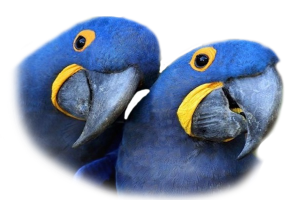 Blue Macaw bird usually mate for their life and the time of their nesting is started in July which goes on till December. Nests are constructed in cliff faces or tree cavities depending on the habitats mainly. However, 90% of their nests are constructed in Manduvi tree where these birds find out a hole first and then enlarge it to fill with wood chunks to transform that hole into nest for their reproduction purpose. One interesting fact is, this bird depends largely on their predators Toucan for reproduction indirectly, the reason is Toucan disperse the seeds of Manduvi tree that is best tree for the reproduction of Blue Macaw.
Blue Macaw bird usually mate for their life and the time of their nesting is started in July which goes on till December. Nests are constructed in cliff faces or tree cavities depending on the habitats mainly. However, 90% of their nests are constructed in Manduvi tree where these birds find out a hole first and then enlarge it to fill with wood chunks to transform that hole into nest for their reproduction purpose. One interesting fact is, this bird depends largely on their predators Toucan for reproduction indirectly, the reason is Toucan disperse the seeds of Manduvi tree that is best tree for the reproduction of Blue Macaw.
The female blue macaws lay a clutch which contains 1-4 eggs, however most of the time it is seen that only one fledging survives, because the other fledging is hatched after several days of the first one and also they are not able to compete with the first hatched baby for food. So, this bird lay more than one egg even though only one is normally fledged and in case the firstborn baby does not survive, the other eggs can compensate for that. This behaviour of the macaw is known as insurance hypothesis.
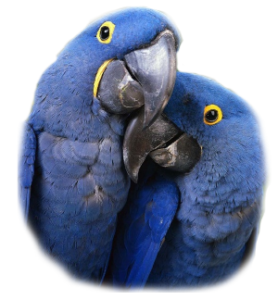 Their incubation period is lasted for around one month and the male blue macaws tend to stay beside the female partner as they incubate eggs. The female do not leave the nest and stay all the time with the eggs still they are hatched while male blue macaws brings food for them during that time. After a month when the eggs are fully hatched, both male and female bird get out for bringing food for them. The chicks leave the nest as they reach the age of 110 days but they still remain dependent on their parents for about six months. The chicks become completely mature and start breeding at the age of seven years, so the reproduction process of this parrot species is usually longer.
Their incubation period is lasted for around one month and the male blue macaws tend to stay beside the female partner as they incubate eggs. The female do not leave the nest and stay all the time with the eggs still they are hatched while male blue macaws brings food for them during that time. After a month when the eggs are fully hatched, both male and female bird get out for bringing food for them. The chicks leave the nest as they reach the age of 110 days but they still remain dependent on their parents for about six months. The chicks become completely mature and start breeding at the age of seven years, so the reproduction process of this parrot species is usually longer.
Diet
Blue Macaw has a very specific omnivore diet which consists of wholly palm nuts and these are typically from two main palm trees. This bird follows a very interesting way to find out nuts with the help of their tongue and toes. Hyacinth macaw forage in cattle lands to look out dung which contains nuts. These are indigestible to cattle but is easily cracked and opened by the Blue Macaws. The diet should contain high fat and palm nut is the best option for that. However, you can always make use of substitutes such as Brazil nuts, walnuts, macadamias, coconut, almonds, pistachios and cashews in case you are not able to find out palm nuts for your pet Blue Macaw.
Fat is easily and quickly metabolized by this bird while they should also be encouraged to eat other fruits and vegetables. Seeds and palette based diet is appropriate for their health. Overall, they should be provided enough care and proper food and this bird can be kept by only those people who have done a great research to know about this species and are well aware of their facts. Expert’s suggestion is also recommended in such case.
Vocalization
Hyacinth Macaw parrot might not be considered as the best talker however, they are pretty good in learning few words and phrases that they keep on repeating over time. This bird is really intelligent that learn to contextualize some words perfectly.
Squeaking and screaming are the main ways through which this bird communicates with each other. They are very loud and prone to screaming. One Hyacinth macaw might not be that annoying while a pair will pump up the volume for sure. Their voice is so loud that it can catch the attention of bird-napper who are looking for such expensive bird for selling. So, if you have kept this parrot species at house as pet, be sure to keep them safe from the hand of potential theft.
Predation
When it comes to predators of Blue Macaw, there are many to name in the list. The most common predators are listed here.
Man:
Man is probably the big predator of Macaw irrespective of any species. Their colourful and bright feathers and meat is the main reason for which they are hunted by men. Also they are one of the most expensive pet in the industry and this is the reason poachers smuggle their eggs to sell them in the pet industry. Another reason to call men as the big predators of Blue Macaw is that, it is only human who are deforesting the habitat of Macaw by cutting down all the trees.
Eagle:
Apart from human, it is Eagle that is the main predator of this bird. Eagle preys on them while they are flying or in the treetops and catch them with ease. Harpy Eagle is very perfect in preying its food and most of the time they ensure to catch the prey by zooming their eyes. Hawk eagles and falcons are also included in their predators list.
Snakes:
Ground is not safe as well for Macaws as they are best food of snakes like anaconda, boa constrictor etc. But fortunately, Macaw is bit faster to fly, so snakes should quickly prey the macaws otherwise they will fly away.
Domestic pets: Domesticated pets such as dog and cat too can pose serious health risk to the blue macaws. This is why they should not be kept in the same room with other pets. Also, any kind of bird does not have much blood in their body and if they are attacked by other pets and suffer huge blood loss, it can lead to their death. So, they should never be left unobserved with other pets at home.
Conservation Status
This Macaw species is now classified as an endangered species based on a released estimate of less than 2500 mature individuals. The main reason of this apparent declining number is their habitat loss and the so called cage bird trade. In the year of 1980, around 10,000 Blue Macaws were taken from the wild and 50% of them were destined for the Brazilian market. Development of hydroelectric schemes, mechanized agriculture and the introduction of cattle ranching are main reason that are depleting the habitats of this bird. Also grass fire set by the farmers and people’s intention to collect feathers of this bird to prepare headdresses and other ornaments are other reasons of endangerment.
But conservation initiative is already started in various places to save this bright and colorful bird from getting aloof. This bird is protected in Brazil and Bolivia by law while commercial export is also banned in all those places. Also the Hyacinth Macaw project in various Brazilian states has created several small nests to compensate their habitat in the required region.
European endangered species programme was started in 1989 and its main aim was to maintain wild population along with solving the lack of successful breeding in captivity. Breeding in captivity is really difficult while the hand raised Blue Macaw have shown higher mortality rates, mainly in the first month of their life. Also the cattle ranch owners in Pantanal and Gerais are continuously taught to protect birds by not allowing any kind of trappers inside their properties.
Studies of current range, extent of trading of this bird and population status are some of the conservation action introduced to save this rare Macaw. Additionally, the effectiveness of artificial nest box of this bird is also assessed to pursue another useful step. Again it is proposed to include this species as endangered under the US Endangered Species Act to follow further protective measures in the USA.
Conclusion
This bright and charming bird is really pleasant to the eyes but unfortunately their numbers are declining with days due to deforestation, people’s hunting for feathers, poachers and other threats. As these parrot species are very rare, many of them are in breeding program to enhance their number. It is expected that some breeders will soon reintroduce this species in the wild. Also they do not look good only as pet at homes rather their presence is must in the wild as well otherwise this beautiful species will soon disappear forever from the world.
